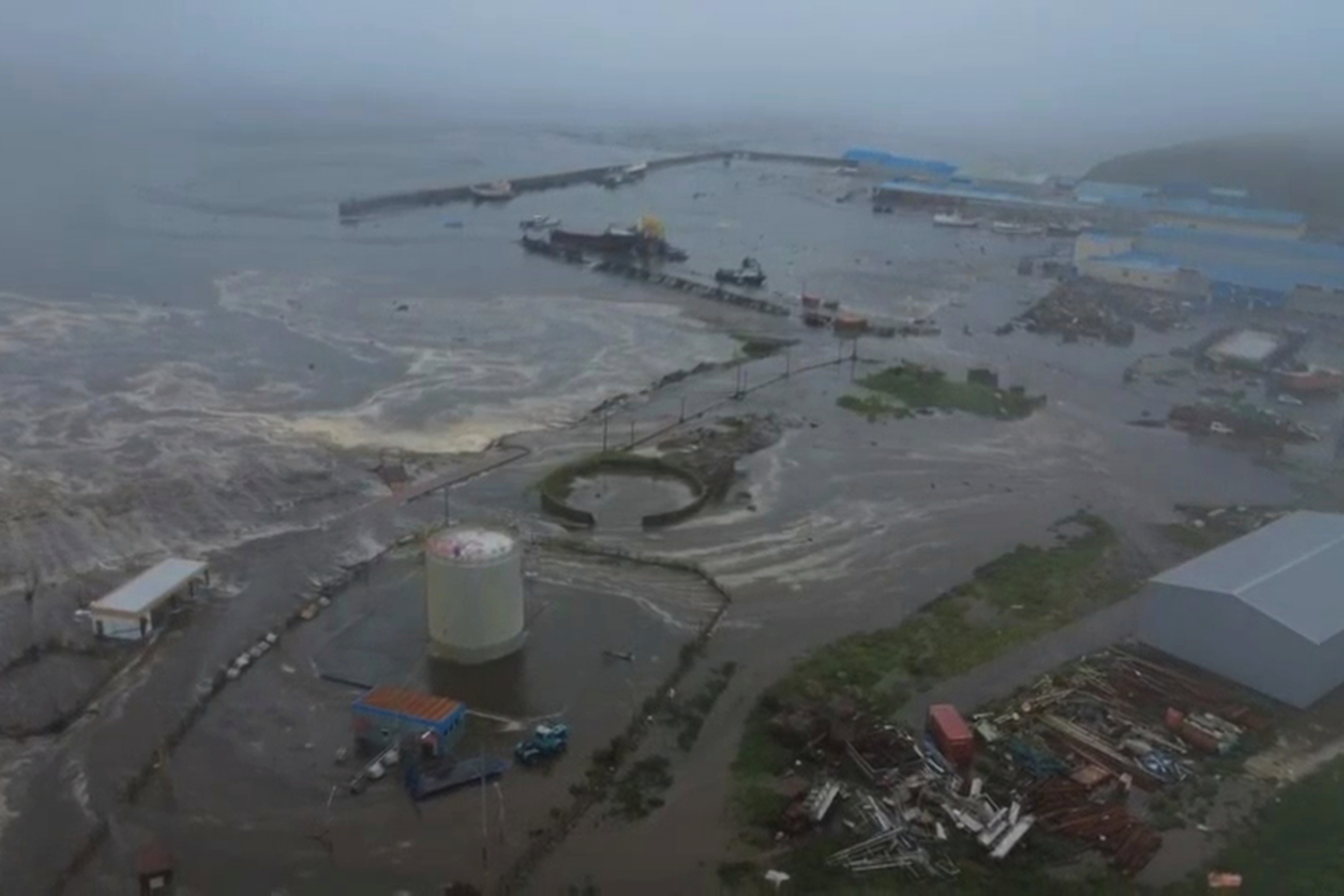The earthquake had a depth of 18.2 kilometers below the seabed with an epicenter 126 kilometers from a sparsely populated remote region that is part of the Pacific Ring of Fire, an area of intense seismic and volcanic activity. It has been the largest earthquake ever recorded since the magnitude 9.1 one that led to the devastating Japan tsunami on March 11, 2011.
The first tsunami waves, measuring between 30 and 60 centimeters, hit the coast of Hokkaido in northern Japan, about 740 kilometers southwest of the Kamchatka Peninsula. Hours later, in Miyagi Prefecture, the Meteorological Agency recorded a tsunami with waves of 1.3 meters. The public broadcaster NHK reported that the waves tore some structures from their foundations as they moved inland. Local channels have aired footage of many residents gathered on building rooftops.
Massive evacuations were accelerated in Hokkaido and in many coastal towns in Miyagi and Iwate, which suffered the worst devastation from the 2011 tsunami, which claimed over 18,000 lives. Workers at the Fukushima nuclear plant were also evacuated following the alerts. The Fire and Disaster Management Agency reported issuing evacuation alerts for almost two million people in 133 municipalities along the Japanese coast, from Hokkaido to Okinawa.
In Hawaii, the first large tsunami waves began to arrive in the late afternoon. One over a meter and a half was recorded on the north coast of the tourist island of Maui. Governor Josh Green urged the population to evacuate coastal areas, warning that the waves would encircle the entire archipelago and could cause flooding. Civil defense sirens sounded twice in Oahu and Kauai, and operations at airports and university campuses were suspended. Green also explained that a 1.8-meter wave passed through the Midway Atoll, located between Japan and Hawaii.
Coastal hotels in Oahu began evacuating guests to higher ground, in coordination with local authorities. Shelters and emergency operation centers were also opened on all islands. Police urged to avoid unnecessary travel to not obstruct evacuation routes, as traffic intensified in the capital, Honolulu, and other densely populated areas.
The US Coast Guard ordered ships to leave Hawaii ports until the tsunami threat passed. "All ports have been closed to maritime traffic, and vessels transiting near the Hawaiian Islands will remain at sea until the situation improves," a statement from the Coast Guard's Oceania District read. Many flights to Honolulu were also canceled or diverted.
On the volcanic island of Amchitka in Alaska, a 30-centimeter tidal surge was observed in the late afternoon. The tsunami alert is active in California and the rest of the US West Coast states, where the impact of the first surges was observed in the Californian city of Crescent City, near the Oregon border.
"A small stretch of the northern California coast is at higher risk of a tsunami because its unique underwater geography has the ability to channel wave energy," noted the National Weather Service. Waves up to 1.5 meters high are expected from Cape Mendocino to the California-Oregon border.
The fear of the tsunami has spread to Pacific islands such as American Samoa, Palau, and Tonga, which issued alerts following forecasts of waves up to a meter above normal tide levels. Although no immediate threat has been declared in the Cook Islands, authorities remain in "active surveillance." A resident of Saipan, the capital of the Mariana Islands, confirmed that gas stations already have very long lines of cars. "It's good to be prepared," he said.
The memory of past false alarms and the increasing vulnerability to extreme weather events have prompted a swift response from Pacific island communities.
In Southeast Asia, the Philippines and Indonesia issued warnings of possible 1-meter high waves. In South and Central America, Peru, Chile, and Mexico joined the countries under tsunami alert. Ecuador, on the other hand, evacuated parts of the Galapagos Islands.
In China, authorities initially announced the "disastrous impact" of waves up to 1 meter in Shanghai and the neighboring Zhejiang province, which were already being hit by a strong tropical cyclone. Over 300,000 residents were relocated to safe areas, and hundreds of flights were suspended. However, tsunami alerts were lifted in the afternoon.
In neighboring Russia, state media reported that the tsunami hit the southeast of Kamchatka with waves up to five meters high, flooding a port city where around 2,000 people live. "The tsunami flooded parts of the port city of Severo-Kurilsk. The population has been evacuated," said the Ministry of Emergencies. No serious injuries have been reported so far. The Tass agency reported that Severo-Kurilsk, located at the southern tip of Kamchatka, declared a state of emergency following the earthquake and tsunami.
A series of powerful aftershocks shook Russia during Wednesday morning. According to the US Geological Survey (USGS), an earthquake of magnitude 6.9 and another of 6.3, along with nine others between 5.4 and 5.8, affected the same areas in the hours following the 8.8 earthquake, which was the sixth strongest ever recorded, according to historical USGS data. It has been classified alongside the devastating 2010 Chile earthquake, which killed over 500 people and caused extensive destruction, and the 1906 earthquake in Ecuador and Colombia, which triggered a tsunami that left over 1,500 dead.
In a statement published on a Telegram channel of the Russian Academy of Sciences Geophysical Service, Russian scientists described the earthquake as a "unique event" and warned that aftershocks could last for a month.
In Japan, one of the viral images of the day was the appearance of four stranded whales, between seven and eight meters long, very close to a beach. Initially, it was believed that this was probably due to the sudden drop in water level, but some experts pointed out that there is no evidence that the tsunami was the reason the whales stranded in that area.
